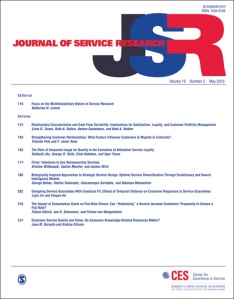Why Would You Choose to Revisit a Dissatisfying Restaurant?
 We’re pleased to welcome Dr. Gabriele Pizzi of the University of Bologna. Dr. Pizzi recently collaborated with Gian Luca Marzocchi, Chiara Orsingher and Alessandra Zammit on their paper published in the Journal of Service Research entitled “The Temporal Construal of Customer Satisfaction.”
We’re pleased to welcome Dr. Gabriele Pizzi of the University of Bologna. Dr. Pizzi recently collaborated with Gian Luca Marzocchi, Chiara Orsingher and Alessandra Zammit on their paper published in the Journal of Service Research entitled “The Temporal Construal of Customer Satisfaction.”
A dirty plate at the restaurant where we were having a research meeting at lunch inspired the intuition behind the research idea portrayed in this work. Just upon the exit, we were so dissatisfied that we promised we would never come back to that restaurant. Interestingly, when choosing a restaurant some months later during another research meeting, one of us proposed THAT restaurant. After all, the atmosphere was pleasing and the room was quiet so that we could discuss about our research plans without being bothered. We started wondering why the evaluation of the restaurant had changed over time. Someone proposed that the details of the experience were forgotten: however, all of us perfectly remembered about the dirty plate. Presumably, over time the relevance of the dirty plate had decreased in our evaluations.
We explain this phenomenon through the lenses of Construal Level Theory, which posits that that individuals generate different mental representation of events that are placed at distinct points in the near rather than the distant future. For example, organizing a party for the next month is construed at a high level of abstraction, in terms of “having fun,” and “seeing friends.” A few days before the party, however, the same event is construed at a low level of abstraction, such as “buying food and drinks,” and “decorating the house.”
We show that construal mechanisms are activated also to reconstruct and evaluate past experiences. Basing on the results of two experiments and a field study, we find that the importance of the attributes driving satisfaction shifts over time, with concrete attributes of the experience ranking higher than abstract attributes in the evaluation of near-past experiences. The opposite happens for the evaluation of distant-past experiences. In addition, we show that overall satisfaction judgments shift over time as a function of the different performances of abstract and concrete attributes. Customers are more satisfied with a service experience featuring concrete positive and abstract negative attributes when they evaluate it in the near past. Conversely, they are more satisfied with a service experience featuring abstract positive and concrete negative attributes when they evaluate the experience in the distant past.
Our findings have several important implications for designing satisfaction surveys more effectively. We advise companies to design surveys that measure satisfaction repeatedly to obtain the whole spectrum of evaluations. Focusing on the so-called online evaluations (i.e., evaluation collected immediately after the service experience is over) may be misleading: Online satisfaction surveys might overemphasize (underemphasize) the impact of low-level negative (high-level positive) attributes on the overall satisfaction judgment. Additionally, the content and the wording of satisfaction surveys are relevant: if the content of the questionnaire and the construal level of the past experience are not correctly paired, it may be difficult to find an exhaustive explanation for the determinants of overall customer satisfaction/dissatisfaction.
In summary, our research shows that when consumers evaluate a service experience that has happened in the near-past (e.g., two days earlier) they rely on concrete service attributes, but they rely on abstract attributes when they evaluate the same experience in the distant-past (e.g., two months earlier). This is why a concrete attribute such as a dirty plate might have been discarded from our distant past satisfaction judgments about the restaurant. Eventually, we came back to that restaurant and we received an unexpected gift at the end of our lunch. But that’s another research project.
You can read “The Temporal Construal of Customer Satisfaction” from Journal of Service Research by clicking here. Want to have all the latest news and research from Journal of Service Research sent directly to your inbox? Click here to sign up for e-alerts.
 Gabriele Pizzi is an Assistant Professor of marketing at the University of Bologna. His research interests include customer satisfaction measurement, intertemporal choices, and inventory management. His work has appeared in the Journal of Retailing, Journal of Behavioral Decision Making, and the Journal of Economic Psychology.
Gabriele Pizzi is an Assistant Professor of marketing at the University of Bologna. His research interests include customer satisfaction measurement, intertemporal choices, and inventory management. His work has appeared in the Journal of Retailing, Journal of Behavioral Decision Making, and the Journal of Economic Psychology.
 Gian Luca Marzocchi is a Professor of marketing and consumer behavior at the University of Bologna. His research specialties include customer satisfaction modeling, waiting perception in service settings, intertemporal choice, and the interplay between brand loyalty and community identification in brand communities. His refereed works have appeared in Journal of Applied Psychology, Journal of Economic Psychology, Psychology and Marketing, International Journal of Service Industry Management, Entrepreneurship Theory and Practice, among others.
Gian Luca Marzocchi is a Professor of marketing and consumer behavior at the University of Bologna. His research specialties include customer satisfaction modeling, waiting perception in service settings, intertemporal choice, and the interplay between brand loyalty and community identification in brand communities. His refereed works have appeared in Journal of Applied Psychology, Journal of Economic Psychology, Psychology and Marketing, International Journal of Service Industry Management, Entrepreneurship Theory and Practice, among others.
 Chiara Orsingher is an Associate Professor of marketing at the University of Bologna. Her research interests include service recovery and complaint handling, meta-analysis, and referral reward programs. Her work has appeared in the Journal of Academy of Marketing Science, Journal of Service Research, Psychology & Marketing and the International Journal of Service Industry Management.
Chiara Orsingher is an Associate Professor of marketing at the University of Bologna. Her research interests include service recovery and complaint handling, meta-analysis, and referral reward programs. Her work has appeared in the Journal of Academy of Marketing Science, Journal of Service Research, Psychology & Marketing and the International Journal of Service Industry Management.
 Alessandra Zammit is an Assistant Professor of marketing at the University of Bologna. Her research interests include context effects, social influence, self-customization decisions and identity based consumption. Her work has appeared in the Journal of Consumer Research and in the Service Industries Journal.
Alessandra Zammit is an Assistant Professor of marketing at the University of Bologna. Her research interests include context effects, social influence, self-customization decisions and identity based consumption. Her work has appeared in the Journal of Consumer Research and in the Service Industries Journal.






























































































